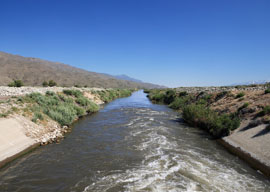
February 22, 2017

Owens Valley aqueduct
Source: Bigstock
In 1972, however, two older dams collapsed, killing 363 and souring public attitudes. Then in 1976 the federal government’s brand-new Teton Dam caved in, and with it the Establishment’s self-confidence in its dam-building ability.
Noah Cross became the poster boy for a legal revolution under way in the early 1970s that sought to keep powerful interests from imposing their externalities on others. New rules demanded that all the costs of major projects be carefully documented and allocated so that promoters couldn”t make out like bandits.
This led to a wide range of expenses being newly incorporated into infrastructure projects, and thus fewer being seen as economically justified.
The biggest winners from the regulatory regime tended to be lawyers, environmental consultants, and the like.
And over time, various official victim groups figured out that they could get in on the racket. The New York Times noted in 1993 upon the I-105 freeway to Los Angeles International Airport finally being finished:
The project was as much social engineering as civil engineering. It was completed only after the builders agreed under a Federal consent decree to spend billions in social programs: new housing for the 25,500 displaced people, job training programs for minorities and women, even tutoring and scholarships for poor children and housing for AIDS patients in West Hollywood, 10 miles from the freeway.
In 1997, Towne wrote in an introduction to his two best screenplays, Chinatown and the superb The Last Detail, about how his favorite golden-age movies such as Sergeant York had created a common belief in what was right about our country:
And even when our society changed dramatically in the “60s and “70s, many films””The Godfather,” “Taxi Driver,” and “Chinatown” among them”found receptive audiences. They did so by dramatizing the disparity between the Establishment’s view of the country and what many Americans were beginning to take to be the awful truth…. Again, a series of shared beliefs, in this case focusing on what was wrong with the country, created a sense of communion between filmmakers and filmgoers.
Towne himself had become disenchanted with the new ideology of victimism that he had helped usher in. In 1997, he kvetched:
Today, of course, [Faye Dunaway’s] Evelyn Mulwray would go on “Oprah” as an abused child, talk about what a bad scene it was banging her pappy, and with Howard Weitzman and her sister-daughter at her side, launch a huge lawsuit against Noah Cross, his partners and corporations, and probably the DWP.
The increased costs and decreased services of the new Chinatown/Jerry Brown legal climate tended to discourage Americans from moving to California. This was not an unintended consequence. Many in California believed, like Towne, that the state in 1937, when the population was about 6 million, had been paradise.
Even Pat Brown of Northern California joked in the 1980s that he had been warned by his aides that his water project was just making it possible for Southern California to attract more Americans. He replied, “I don”t want all these people to go to Northern California.”
But of course there remain plenty who profit from increased population in California. While the Noah Crosses of the past at least provided infrastructure to attract more Americans to their state, their 21st-century equivalents have hit upon the genius plan of not providing infrastructure while inviting in millions of foreigners.
And if anybody points out that the immigrants they import to pick their crops and wash their cars bring externalities, the new Noah Crosses can just accuse their skeptics of being racist.